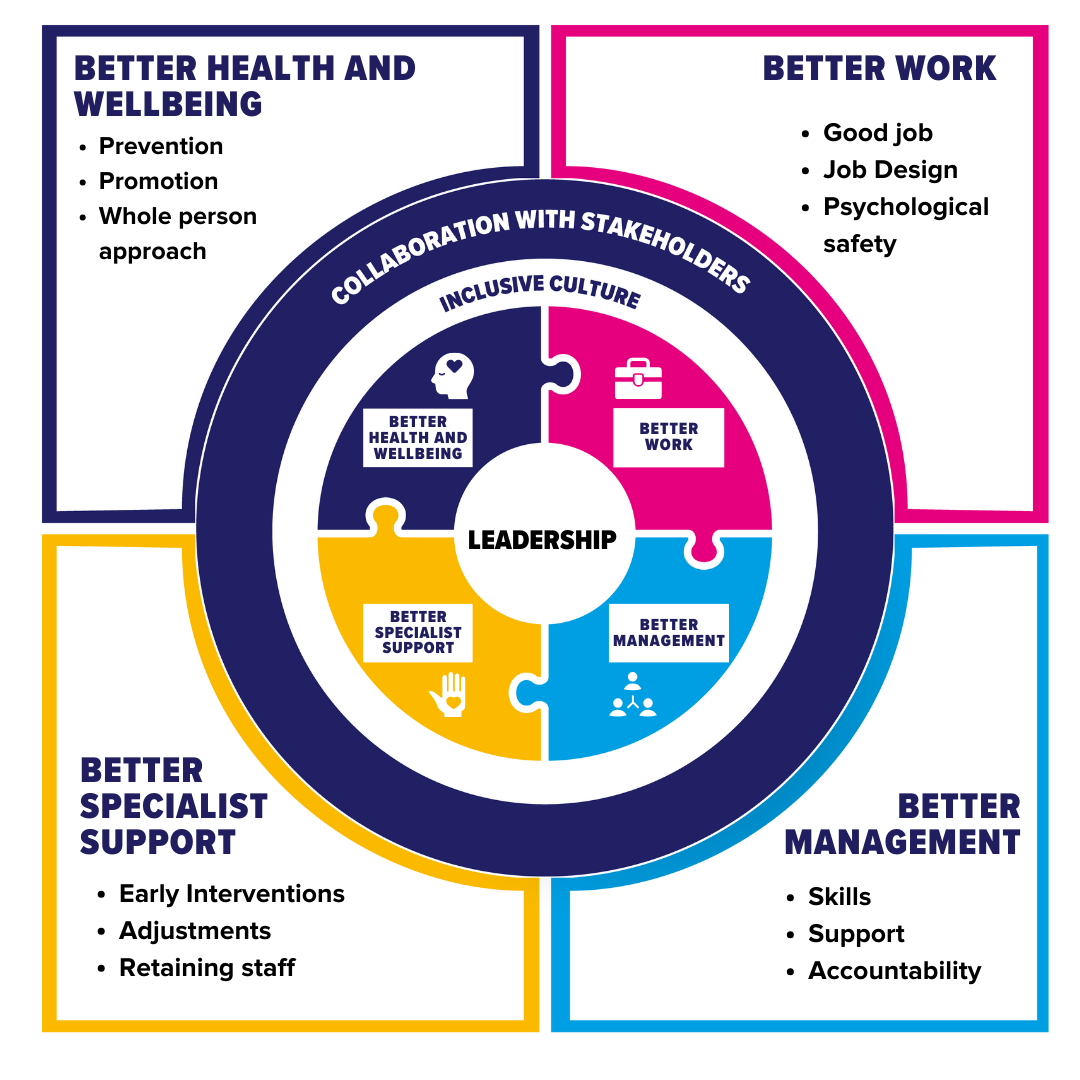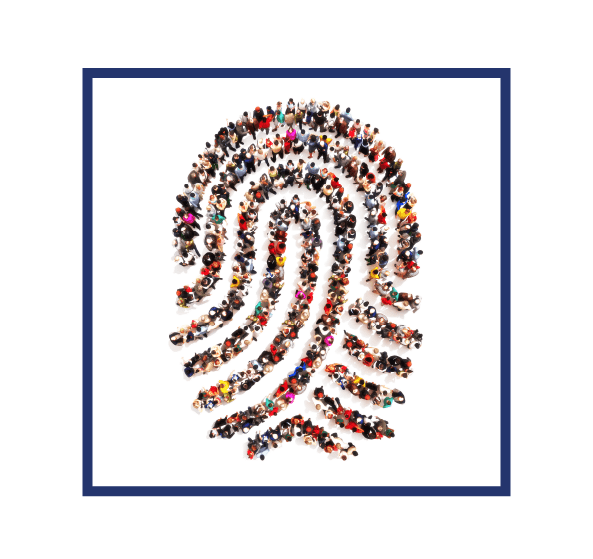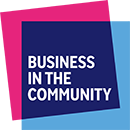The Business in the Community Workwell Model

The Workwell Model
Thriving People,Thriving Business, Thriving Communities
The model is evidence-based, widely endorsed and positions thriving people at the heart of organisational purpose, culture and business strategy, enabling sustainable, employee health and wellbeing. It provides a unique “gold standard” framework for an intersectional and inclusive approach, enabling individuals, teams and organisations to thrive.
BITC defines workplace wellbeing as employees feeling satisfied and energised with and by their work and finding purpose in their careers. Thriving employees are those who report high workplace wellbeing. What makes for thriving employees is the mutually supportive relationship between mental, physical, financial, social and environmental health.
Health and wellbeing are key components of Business in the Community’s Responsible Business Map.

cOMMIT TO REVOLUTIONISING
WELLBEING AT WORK

The Workwell Model explained
Leadership
UK PLC has made considerable strides in raising mental health awareness, but this is not translating into mainstream improvements.
We need to tackle the systemic root causes of poor mental health by leaders owning the creation of good work that enhances wellbeing, and improves productivity.
Actions:
- Consciously advocate role model behaviours that promote health and wellbeing.
- Enable an inclusive culture by embedding wellbeing into management accountability and operational policies and tools.
- Publicly report on your wellbeing performance in external communications such as annual reports.
Resource to get your organisation started:
Standard: Mental Health at Work Commitment standards 1 2, 3 and 6
Better health and wellbeing
Take a whole-person approach to wellbeing. The four pillars of wellbeing are physical, mental, financial and social health and wellbeing. All of which are inextricably linked.
Actions
- Focus on three areas:
Prevention (primary focus)
Early intervention
Active rehabilitation
- Create environments that enable employees to make informed, healthy choices.
- Encourage employees to take ownership of their own health and wellbeing.
Resources to get your organisation started:
Webinar: BITC An Introduction to Wellbeing – An Introduction to Wellbeing
Toolkits: BITC and Public Health England suite of Toolkits
Standard: Mental Health at Work Commitment standards 3 and 5
Better work
Create good work and working conditions that enhance employee wellbeing.
Actions:
- Audit the mental health risks in your workplace, as well as physical ones, and develop a plan for minimising them.
- Increase leadership and management’s understanding of the positive and negative impact work can have on employees and hold them accountable.
- Regularly monitor and report on working conditions and always include employee feedback.
Resources to get you started:
Report: Health and Safety Executive stress at work
Risk Assessment: Health and Safety Stress Risk Assessment
Survey Report: CIPD Good Work Index
Standard: Mental Health at Work Commitment standard 2
Better management
Make employee mental health ‘business as usual’ for all leaders and people managers.
Actions:
- Embed the prioritisation of good mental health as a core competency for people managers.
- Recognise and reward empathy and compassion.
- Ensure comprehensive training reaches all managers and includes the impact work can have on employees and how to prioritise employee health and wellbeing.
Resources to get your organisation started:
Report: BITC Mental Health at Work 2019 – Time to Take Ownership
Webinar: BITC Mental Health at Work 2019 -Time to Take Ownership
Standard: Mental Health at Work Commitment standards 2, 3 and 6
A series of videos were produced to launch the BITC Mental Health at Work 2019 – Time to Take Ownership report, featuring employees and managers from Anglian Water, Costain, Bupa, Santander, National Grid, and Lloyds Banking Group.
Better specialist support
Take an inclusive and employee-led approach to providing support.
Actions:
- Develop active listening and communication skills and introduce training on tailored workplace adjustments and modifications.
- Training for employees to equip them to manage their wellbeing better.
- Provide and promote access to diverse inclusive health and wellbeing services and facilities such as employee assistance programmes and occupational health.
Resources to get your organisation started:
Toolkit: BITC / Public Health England Health and wellbeing toolkit suite for employers
Publications: Business Disability Forum publications
Standard: Mental Health at Work Commitment standard 5
Inclusive culture
Employers must adopt a tailored employee-led approach to address workplace culture that recognises the complex needs of different groups.
Actions:
- Promote and implement zero-tolerance policies and guidelines.
- Collect diversity data to inform your health and wellbeing strategy.
- Consider wellbeing through the multiple, intersectional lenses required for people to bring their whole self to work.
Resources to get you started:
BITC Focus Area: Age and multigenerational teams
BITC Focus Area: Gender
BITC Focus Area: Race
Standard: Mental Health at Work Commitment standard 3
Collaboration with stakeholders
Look externally for the best support or services and promote wellbeing among stakeholders. This network of external support helps improve both your organisation and build a movement towards achieving improved health and wellbeing.
Actions:
- Work with other businesses, your supply chain, and partner organisations.
- Use your industry network as a source of information and support.
- Develop strategic partnerships with health and wellbeing charities, forums and professional bodies to keep up with developments.
Resources to get your organisation started.
Join Business in the Community: Together we can make change happen.
Standard: Mental Health at Work Commitment standard 4
Workwell Model evidence paper by Dr Fiona Adshead
Download the reference document:
Dr Fiona Adshead, Independent Wellbeing, Sustainability and Public Health Advisor and member of BITC’s Wellbeing Leadership Team
Next Steps

Take the Business in the Community Self-Assessment
- Understand your starting point and track progress by completing our Workwell Self-Assessment.
Make the Business in the Community Workwell Commitment
- Sign up for the Business in the Community Workwell Commitment and start a journey towards measurement and public reporting on employee health and wellbeing.
Taking the Self Assessment and making the Business in the Community Workwell Commitment is free and open to organisations and businesses of all sizes and sectors.
Supporting resources
Prioritise People:
unlock the value of a thriving workforce

A game-changing report that makes a compelling business case for thriving people.
Prioritise People Report Insight Summary Deck

Initiate a boardroom discussion about the value of investing in a thriving workforce using our presentation deck.
Your Job Can
Be Good
For You

Backing business
to revolutionise ways of working
in the UK
GLOBAL GOALS
TOGETHER WE CAN MAKE CHANGE HAPPEN

